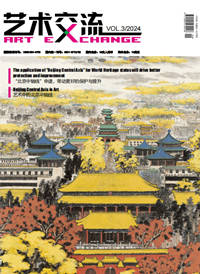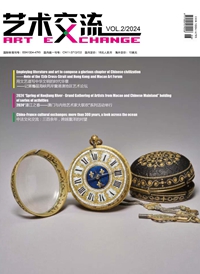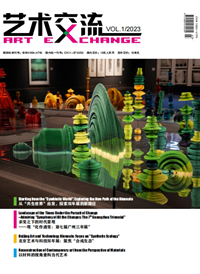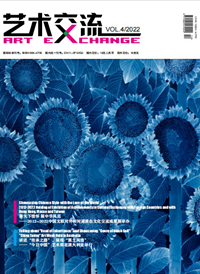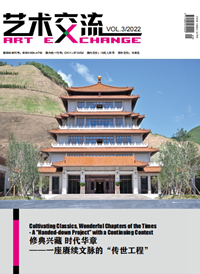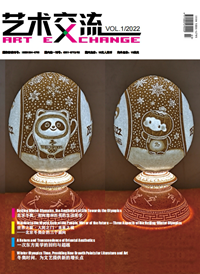What did the Chinese artists do in France?
Art Exchange VOL.Art Exchange|Yang Yang
What did the Chinese artists do in France?
Story of Pioneering: Chinese Artists in France and Modern Chinese Art (1911-1949)

In 1935, Hua Tianyou took a group photo with Chinese students. From the left of front row: Zeng Zhushao and Liao Xinxue; from the left of the second row: Huang Xianwen, Lv Sibai, Tang Yihe; from the left of the third row: Hua Tianyou, Chang Shuhong, Chen Shiwen; back row: Wang Linyi.

In 1936 in Paris, members of the conference of Chinese Students' Association in France discussed about to participate in the exhibition in London. From the left of back row: Li Ruinian, Zhou Qingding, Zeng Zhushao,Ma Jiyu, Chen Zhixiu; from the right of back row: Zhang Ziyu, Lv Xiaguang, Chen Shiwen, Huang Xianzhi; from the right of front row: Hua Tianyou, Wang Ziyun; from the left of front row: Zhang Xianfan, the little girl is Chang Shana.

Portrait of A Young Woman (oil on canvas) 1930 Maurice EHLINGER

Image of Lady in Manchurian Dress (oil on canvas) 1920 Wu Fading

The lady and knight on the riverside (oil on the canvas) 1878 Adolphe Lalyre

Son of the earth (paper watercolor) 1934 Pang Xunqin

Flower in Vase (oil on canvas) 1946 Qin Xuanfu
Studying abroad is one of the most epoch-making phenomena in Chinese history, especially in the history of culture in the first half of the 20th century. In the field of fine arts, most of the Chinese artists staying in France chose to study at the National Academy of Fine Arts in Paris, France, with oil painting, sketching and sculpture as the main research subjects. In France, they received the education of Western academic classicism, realism, and realism art, and brought back the ideas of western modernist schools, bringing oil paintings, sculpture, sketch, toner, and gouache and other new art categories and concepts outside the traditional painting and calligraphy system of the Chinese art in the 20th century, even pertinent new lifestyles, making them one of the important groups quite active in the first half of the 20th century in China, laying the foundation, which changed and enriched the Chinese art in the first half of the 20th century.
From January 12th to March 3rd, the "Pioneering: Chinese Artists in France and Modern Chinese Art (1911-1949)" exhibition, organized by the Central Academy of Fine Arts with support of the Art Museum of the Central Academy of Fine Arts and the Long Museum, has been held at the Central Academy of Fine Arts in Beijing.
The exhibition comprises one main exhibition - " Pioneering: Chinese Artists in France and Modern Chinese Art (1911-1949)" and three special exhibitions - "Hometown of Others: Society of Fine Art of Chinese Artists in France" "The Stones from Other Hills: Chinese Artists in France and Modern Chinese Sculptures" "Respecting: French Teachers for Chinese Artists in France", displaying more than 200 works of more than 40 Chinese Artists in France, as well as related literature and video materials etc. to present the audiences with a comprehensive artistic profile of these Chinese artists in France.
An incubator-like art group
At that time, these artists went abroad and embarked on the road to study in France with great enthusiasm. In the foreign land, facing new artistic concepts and trends of thought.... how did they learn art better, and how should they give back what they have learned to their motherland? On April 2nd, 1933, Chang Shuhong, Liu Kaiqu, Zeng Zhushao, Wang Linyi, Lv Sibai, Tang Yihe and other groups of art students staying in France established the "Society of Fine Art of Chinese Artists in France" in Paris, forming the "organization that requires a closer, more pure art group" with the purpose of "the sincere attitude for mutual understanding and research" and "freely commenting on the status quo of the art world and the pertinent problems", realizing rapid development.
Wind of Art, the journal of the the Society of the Fine Art of Chinese Artists in France--- this piece of paper in the showcase has been damaged and the text is faintly discernible, the important carrier and cover of the Wind of Art of the Society of Fine Art of Chinese Artists in France to spread the development of Western art to Chinese people. In August, 1934 and November, 1936, the Society of Fine Art of Chinese Artists in France published the "Special Issue of the Society of Fine Art of Chinese Artists in France" and "Special Issue of Modern Art" through Wind of Art, introducing the various artistic schools in the West to China in a systematic manner, and explaining the development of modern Chinese art from different angles, sowing the seeds of Western modern art, which has been named the "epoch-making discourse" by the critics. Chang Shuhong, Chen Shiwen, Zheng Ke, Liu Kaiqu, and Wang Linyi published 90 articles in various editions of Wind of Art. The Society of Fine Art of Chinese Artists in France has also become an important communicator of world modern art in China and made an indelible contribution to the progress of modern Chinese painting.
On the eve of the full-scale outbreak of the Japanese invasion against China in 1937, a large number of members of the Society of Fine Art of Chinese Artists in France returned to China and invested in the historical movement of defending the family against the enemy. Meanwhile, they became active promoters of Chinese art education and practice. Until March 24th, 1945, the 58th Congress of the Society of Fine Art of Chinese Artists in France has been held, marking the return of normal operation of the organization before entering into another active period. Members of the organization, such as Hua Tianyou, Pan Yuliang and Chang Yu, have actively explored the artistic path of the combination of Chinese and Western art with their respective artistic practices. Their achievements have been increasingly recognized by the mainstream French art circles. Meanwhile, they continued to introduce the Chinese art to the West, generating great impact, becoming an important bridge for China-France cultural exchanges.
From its establishment to the 1950s, the activities of the organization have lasted for two decades, gathering 111 Chinese artists in France, including Chang Shuhong, Hua Tianyou, Pan Yuliang, Wu Guanzhong, Zhao Wuji and Lv Xiaguang. In the exhibition hall, their names are recorded on the "Glory Wall" one by one. As an art group, the Society of Fine Art of Chinese Artists in France is more like an incubator, as the artists coming out from here have had a very important influence on the development of Chinese art in the 20th century.
Important link in immigration of civilization
In the last century, the Chinese artists wrote one of the most beautiful chapters of modern art in France. The connection between Chinese artists and their French peers plays a crucial role in the migration of diversified technological elements from one civilization to another.
Chinese artists' studying in France inevitably formed a "mentoring" relationship with French artists. The entire generation of Chinese artists from Wu Fading, Xu Beihong, Lin Fengmian, in the early 20th century to the 1920s, to Wu Guanzhong and Liu Ziming in the late 1940s and early 1950s, have shouldered the trace of French painters both in terms of art techniques and concepts.
Whether at the National Academy of Fine Arts in Paris – the main position of the Chinese in France, or the academies libres in Paris, such as the La Grande Chaumiere, young Chinese artists established sound relationship with their French teachers, such as Jean Chabé and Liu Kaiqu, Henry Buschal and Zeng Tianyou etc., not only affecting how they mastered the techniques of sketching, oil painting or model making, but their thinking in some aspects, such as understanding of pertinent issues like beauty, art and artists' status in society.
The French painter Pascal DAGNAN-BOUVERET used to be Xu Beihong's mentor. He once described art learning as follows: "Art is hard to be, don't admire fashion, and don't be satisfied with small achievement". Xu Beihong obeyed the guidance of his tutor, as he refused to be admired and exaggerate, achieving a more ambitious art and education plan, which has even influenced the development direction of Chinese contemporary art. Similarly, Wu Guanzhong was excited to mention the influence of Jean Souverbie on his composition and the influence of Andre Lhote on his color.
More than 100 years ago, these young artists took the initial heart of artistic ideals and boarded the cruise ship Bordeus. After more than a month of sailing, they came to Paris, the world's art capital at that time. They were not afraid of hardships, trying to explore and studying the Western style and fusion law in art, and understanding the historical context of Western art from a cultural perspective. They are a group of "pilgrims" of art. What they brought back are not only the systems and methods of Western art and art education, but also the passion and ideals of revitalizing Chinese art and education accordingly. "Hundreds of Chinese artists have traveled to a country, but their access is multi-dimensional and rich. After returning to China, the development of their forms of art is diverse, forming a pattern of competition. This fully reflects the Chinese artists' strong ability to absorb and transform the world's cultures.It is just due to the diversified and inclusive artistic mind that the Chinese art in the first half of the 20th century has a new and refined landscape, which has cultivateda rich and fertile soil for the development of the country's art. "said Fan Di'an, president of the China Artists Association and dean of Central Academy of Fine Arts.
Copyright © 2011 CFLAC Corporation, All Rights Reserved




